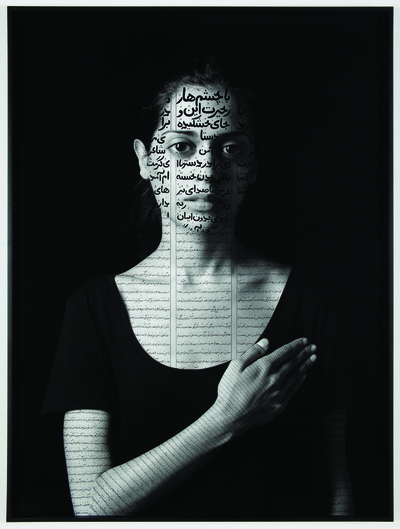SHE WHO TELLS A STORY: WOMEN PHOTOGRAPHERS FROM IRAN AND THE ARAB WORLD
Managing to sidestep the current political turmoil of the Middle East, this special exhibition focuses on the individual narratives of 12 featured female artists to tell their stories.
Several of the artists are well known—Shirin Neshat, Lalla Essaydi, and Rania Matar studied in and have exhibited widely in the U.S.—but the exhibition is particularly ambitious in creating a forum for many new artists. It is timely, offering audiences a glimpse of life for women in the Middle East, and an opportunity to expand understanding of the social and cultural references these images eloquently bring to the surface. It is curated by Estrellita and Yousuf Karsh Assistant Curator of Photographs, Kristen Gresh.
The exhibition opens with Lalla Essaydi’s provocative interpretations of the female body, here translating the 19th-century reclining odalisque in patterns and drapery constructed of bullet casings. Her subject is further adorned through calligraphy inscribed with henna across her skin and clothing, a sacred Islamic art form generally practiced only by men. Another body of work incorporating calligraphy is installed nearby, Shirin Neshat’s disarming portrait series Book of Kings, based on the epic 1000-year-old Persian poem. The ancient text travels across the faces of her subjects in an impossibly fine hand, linking its tales of heroism, rebellion, and violence with these modern day warriors. Her ardent portraits stand as representatives for the thousands who protested in the streets during the Arab Spring of 2011.

Shirin Neshat, Roja, 2012, photograph, gelatin silver print with India ink. © Shirin Neshat, Charles Bain Hoyt Fund and Francis Welch Fund, Courtesy, Museum of Fine Arts, Boston.
Many of the artists explore aspects of what is hidden, what is forbidden, and the decades of loss women have endured. Nermine Hammam and Gohar Dashti present daily life through fictional narratives. Hammam constructs discordant digital collages of youthful Egyptian soldiers, armed but oddly relaxed, superimposed against brilliantly colored travel postcards. Dashti, based in Tehran, constructs ordinary scenarios for her fictional couple to inhabit, but situates them in a treacherous landscape. In the cover image of the catalogue, the couple appears as bride and groom, alighting on married life in a shell of a car stranded in the midst of a battlefield.
As the first major exhibition and catalogue of its kind in the U.S. to address this subject thoroughly, one senses not only a pivotal moment in our history, but a pivotal one for the artists as well, their stories launched to a broad international audience.
